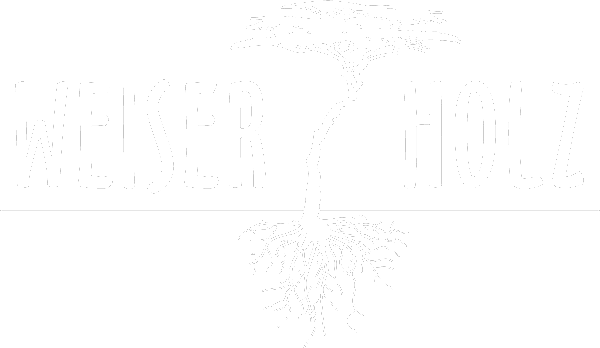About the Robinia
The Robinia (Robinia pseudo-acacia „L”)
 Names: Robinia, Robinie (German), Black Locust (English), Robinia (Italian), Belaja akacija (Russian), Robinier (French).
Names: Robinia, Robinie (German), Black Locust (English), Robinia (Italian), Belaja akacija (Russian), Robinier (French).
In many countries it is called locust-tree. It causes misunderstanding, because it might be mixed up with real acacia that is grown in tropical, semitropical areas. (Acacia genus)
History: Robinia was brought into Europe with lot of other species of plants in 1601 by J. Robin royal gardener from Paris. (According to the geological researches about the tertiary, robinia was found in Europe as well.) The spread of robinia was extremely fast in Europe especially in Hungary. Nowadays the 19.8% of the Hungarian forests are robinia and there is no more robinia forest in Europe than in Hungary. (In Hungary there are 320 thousand hectare of robinia forest.) Therefore Robinia is regarded a typical Hungarian tree species in timber trading. Robinia likes warmer climate and nutrient-rich sand soil. (It requires climate like grapes.)
Characteristics of robinia
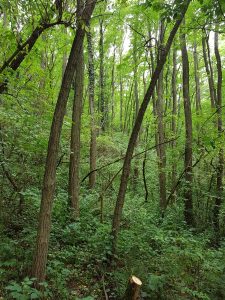 Robinia grows 25-40 metres and grows 30-60 centimetre breast height diameters. After 30 years its growing is getting slowly strongly so it is cut when it is 30-40 years old. Its bark is cracky reticulated way, thick, greyish brown. Older ages its volumetric ratio reaches 20-25 %. It grows straight and cylindrical trunk in close stand. Spreading the straight and cylindrical trunk trees, so called ‘spar acacia’, would deserve more attention.
Robinia grows 25-40 metres and grows 30-60 centimetre breast height diameters. After 30 years its growing is getting slowly strongly so it is cut when it is 30-40 years old. Its bark is cracky reticulated way, thick, greyish brown. Older ages its volumetric ratio reaches 20-25 %. It grows straight and cylindrical trunk in close stand. Spreading the straight and cylindrical trunk trees, so called ‘spar acacia’, would deserve more attention.
The fabric traits of Robinia
Macroscopic structure: in the point of the texture of the robinia it belongs to the annular porous leafy types of trees. (Together with the oak, elm, ash, sweet chestnut and so on.)
Sapwood and duramen: Robinia has thin alburn. (The layer of the sapwood contains 2-6 age-ring.) The alburn is light yellow, the colour of the duramen changes from yellowish brown to greenish grey. There is no material for duramen in the sapwood so the mechanical parameters are fallen off the duramen. Amongst the materials for duramen the most important ones are the valonia, the resin, the colourings, the rubber wood and the robinetin.
The viewpoint of the permanency of the robinia the sort of tannin and the robinetin are the most significant. To the effect of the materials the capability of resistance of the duramen increases.
The sapwood contains a lot of water and a lot of simple organic materials, for this fungi and insects attack this part of the tree firstly.
By Hungarian and foreigner experiences the practical permanency of robinia can estimate this way:
- Outside, being in contact with the soil- 25-40 years
- Outside, not being in contact with the soil- 80-100 years
- Inside, in dry place and under the water- over 500 years
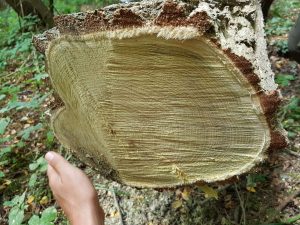 Age-ring structure: The robinia, as the annular porous types of trees, contains well differentiated age-rings and inside it there are early and late bords.
Age-ring structure: The robinia, as the annular porous types of trees, contains well differentiated age-rings and inside it there are early and late bords.
The wood fibres are 1 mm long and have thick walls. The quantity is 56-60%. They cause the exceptional solidity in the robinia.
Faults and damages of the tree
Faults in the texture: We should pay attention more to the unequal wideness of age-ring, to the eccentricity, to the assumed age-rings, to the bark ingrowth and last but not at least to the knobs. (In the practice discoloration which comes from the dry-rotten knobs is called ‘main nervure’.)
Biological damages: Robinia has specific fabric structure and chemical combination and therefore it resist to the biological damages. The standing robinia has only one significant harmful fungus that is ash polyporus, which causes the dry-rot of the foot. The fabric structure and chemical combination of the robinia likewise fungi is unbeneficial for the insects. We often can observe sapwood-beatles’ damage in the sapwood of the stored and build-in trees.
The faults and formal features of robinia roundwood: According to our observations the diminution as a fault of the wood occurs 20-24 % of the timber logs. 15-20 % of the processed logs are plane-curved in the wood-mills. The length of the slub of the stump is not significant, generally it is not over 50 cm.
Besides tannin dihidrorobin has significant role in the permanency of robinia. It is observable in the duramen of the robinia with 2-5 %. Because of this additional material robinia has that typical greenish- yellowish-brownish colour.
Crystal deposits (calcium carbonate, calcium oxalat) are observed firstly in the woodray but ocasionally in the vessels. These strongly make for effect which takes of the edge of the tools.
By the national standards of United Nations 350-2 only robinia can be counted into the 1st resistance category. The robinia may considered environmentally friendly without its chemical manipulation because of its outstanding permanency.
Physical characteristic
Density: the interioir robinia is dry, its density is 728 kg/cubic metre. (Molnár S. 1988)
The function of the water of condition is significantly less compared to other popular species, as the robinia alive contains only 30-40 % humidity. It is worthy to know for carriage: 1 m3 15-20 % net humidity so called airdry robinia is 780-800 kg, but the freshly produced living wet tree is 930-950 kg.
In the case of the robinia the quotient of tangent and radial parameters is very positive. The robinia is less inclined to warp than oak and beech. (It is in connection of less sized and numbers of wood ray.)
We should notice that there are significant inner stresses in the robinia. These often couse different changes of the form and gaps.
Thermodynamical characteristics
Because of its big density the robinia catch fire hard. For burning the minimal heat radiation intensity of robinia is 2.6, of oak and beech is 2.5, of pine is 1.7 W/cm2.
Solidity and flexibility characteristics
Out of the species which are grown in Middle-Europe robinia has the most outstanding solidity and flexibility characteristics.
Static bending strength (u=12%): 156.1
Static bending flexibility (u=12%) 15890
Here is the compressive strength, tensile strength and shear strength parameters of robinia:
| Compressive strength | MPa |
| – Paralell with the fibres | 68,8 |
| – Normal to the fibres | 18,5 |
| Tensile strength | 166,8 |
| Shear strength (tangential) | 12,3 |
The robinia goes before the well-known european species in view of impact-bending strength that characterized by the toughness of the timber. (J/cm2)
- Own research (Hungarian acacia): 16,4
- pedunculated oak : 6,0
- hornbeam: 10,0
- beech: 5,2
The abrasion rate of different species is compared to the beech. So the order of the most important species:
| Robinia | 0,37 |
| Beech | 1,0 |
| Ash | 1,53 |
| Oak | 1,56 |
| Pine tree | 1,73 |
| Alder | 3,3 |
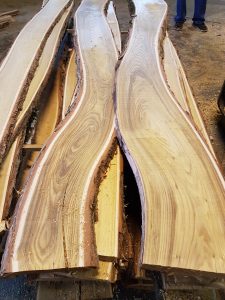
Therefore the abration resistance of robinia is outstanding amongst the European species.
The nature of the processing of robinia
Timber industry utilisation
Because of the small diameter of the timber industry commodity (general 23-24 cm) there isn’t knot-free belt in the wood block. The distance between the bigger knots is 60-68 cm, and there are smutted knots as well. By the reason of it, totally knot-free products hardly produced from robinia which is longer than 1 meter.
The robinia can sawn hard because of its durity and solidity parameters. Comparing to the oak the sawing resistance of the robinia is bigger with 20-30 %, and its effect that takes of the edge increases in the same degree. Robinia does not need special protection (for example spraying) while it is stored in timber space.
Drying
The robinia can be dried well. (Just like the beech.) Its significant benefit that it has low starting humidity. By our experiences the net humidity of the timber is 30-35 % after the logging when it is sawn in 1-1.5 months. (The humidity of oak 50-60%.) This relates to the nature that robinia timber, parquet frieze and furniture lath can be put into artificial driers immediately after the cutting of the log and can be dried without damaging. So there is no need to pre-dry.
Surface treatment
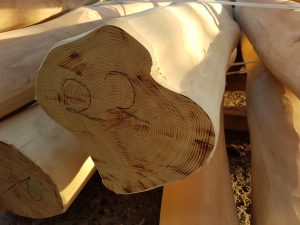 The well-known surfacing technologies can be usable well. The diversity of the colours is restrainable with a treatment with hidrogen peroxid or with curing.
The well-known surfacing technologies can be usable well. The diversity of the colours is restrainable with a treatment with hidrogen peroxid or with curing.
In Hungary the most parquet, stairs, fence are made of robinia. Production of the building constructions, glued beams, wooden houses, sheds, parst of fences and wainscot is remarkable.
Beside the pin slot parquet the production of band parquet and surface abrasive layer are significant as well.
The robinia is used in the wheelwright industry to make strigs in large quantities.
We have to say about the production of robinia barrel. Wine-cask was made of oak in earlier centuries, therefore there was disinclination over against the robinia barrels in the beginning. (15-20 years ago) For today it was out that robinia is excellent commodity of barrel industry. The wood do not let the liquid through any cutting direction. Robinia staves rarely break during bending. The fragrance and colour of robinia have no negative effect to the quality of the stored wine.

